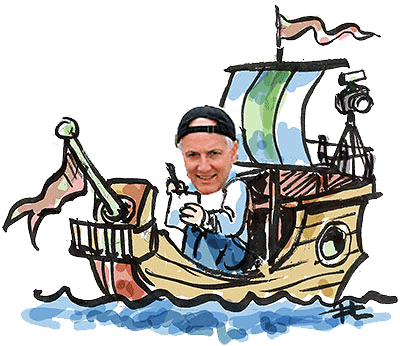When I was a child in a Kansas suburb of Kansas City and my parents and I took vacations, we usually went west. My father, a traveling salesman, was very used to driving long distances in the Buick, and what seemed daunting road trips to some were just more interesting driving to him, a welcome change from the small towns in Kansas and Missouri he regularly traversed. When on a road trip, my father’s supply of energy was inexhaustible, though he caught breathers now and then when my mother took the wheel. Huge swaths of the west were covered in seemingly impossible time spans, with activities and famous locations carefully plotted along the way, though we often detoured to the serendipity of roadside attractions that caught our fancy. One sojourn, toward the ultimate destination of California’s Disneyland, took us through the Southwest. Though it was just a segment along the way, Arizona loomed long and strong in my memory. Its striking, forbidding landscapes, so different from the lush agricultural land of eastern Kansas, were imprinted on my young mind. The Grand Canyon, the Painted Desert, the Petrified Forest, each rolled into memory as we rolled through them.

We traveled much of fabled Route 66 before the Interstate Highway system had most travelers passing most of it by. Indian “trading posts” where crafts and turquoise jewelry could be bought, and occasionally tribal dances were performed, were siren calls to travelers seeking a lemonade or soda break from the summer heat shimmering on the long straight stretches of road once one was out of the mountains. The occasional giant and often goofy statues of dinosaurs, beckoning travelers to attractions such as dinosaur footprints in stone, and reptile exhibitions of rattlesnakes and Gila Monster poisonous lizards, and places where fossils or polished semi-precious gemstones or slices of petrified wood might be had. We did this trip before we had a car with air-conditioning, so when we hit the desert lands we tried to time them to avoid the worst heat of the day. This meant the early morning or late afternoon light often showed them at their most vivid, and the colors amazed me. I’d never seen the reddish and purple hues covering large tracts of earth, sand and stone before, the result of mineral oxides.
Those memories stayed without revision for nearly half a century. When an opportunity to explore Arizona came last Spring, I leapt at it, But I was also a little worried that my outsized memories wouldn’t hold up, that like many memories they would diminish with the perspective that comes from layering on additional decades. I wondered if these places so magical in my young minds eye might, like many places one returns to as an adult, would just seem “smaller” than when viewed as a child.
Not to worry, the touchstones of Arizona hold up splendidly, and the feeling I took with me was the wish to return soon with one or both of my kids to see these unique vistas once again through a child’s eyes.
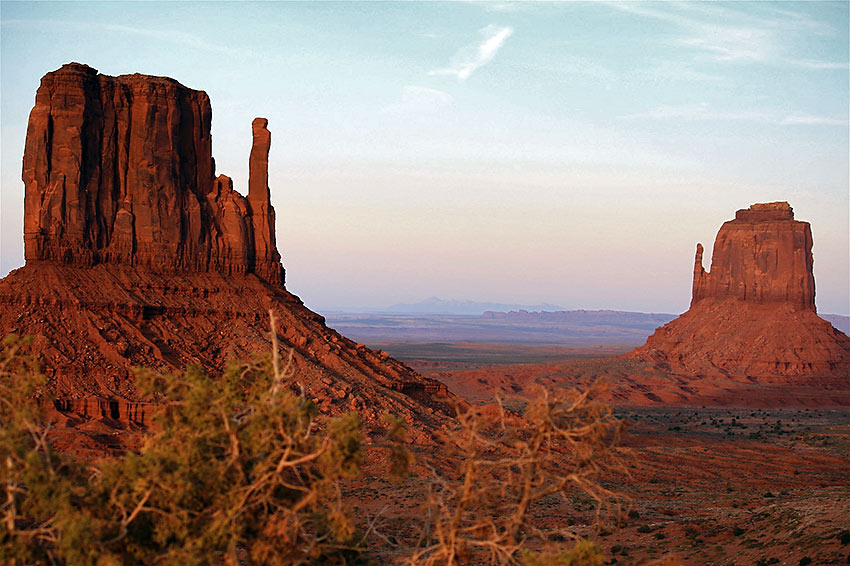
And some places were new to me. Monument Valley, for instance. I think at best my family skirted the edge in the mad dash to the California coast. There was too much to cover in between, like a great aunt in Phoenix, and the goal of timing the drive across California’s Death Valley in the cool of night. We’d already visited Carlsbad Caverns in New Mexico, and made a quick trip over the border to Juarez, Mexico, back before it was a no-man’s land war zone. So from the sidelines and afar, after seeing the Grand Canyon, Arizona’s buttes and plateaus like those of Monument Valley were just interesting road markers. So much distance to cover in a short time, it was like performing triage on the West’s greatest hits.
But on my second trip to Arizona, when I went deep into Monument Valley, the famous landscapes photographed by Ansel Adams were as exciting and curious as they would be to a young boy, the sense of scale and the crazy rock formations framed by the wide open spaces that will always be preserved, always timeless. And if the sun isn’t just right to catch them to best advantage in a photograph, one can always do them in black and white, wishing they’d turn out like an Ansel Adam’s photo, allowing the shadows and contrasts to star in the show.
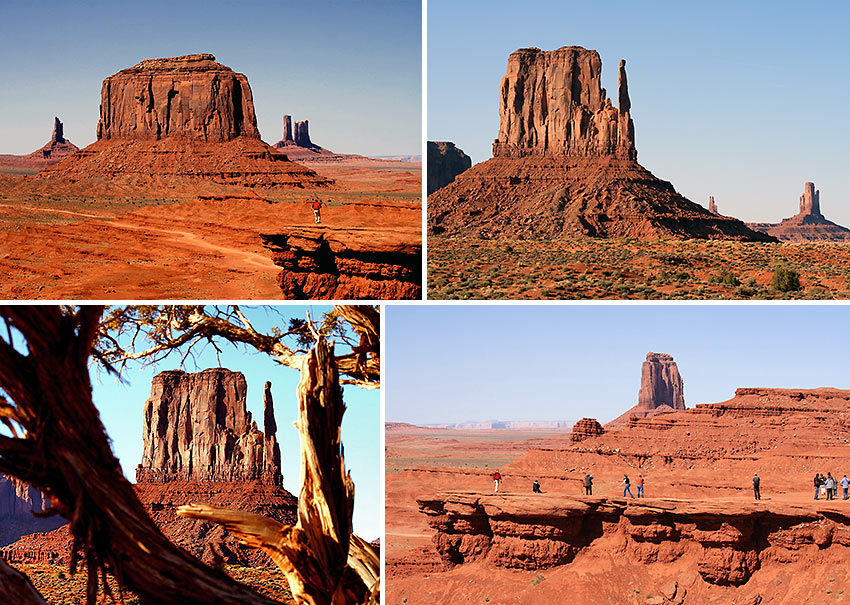
For those of us who grew up with Westerns as popular movie fare, even the first time in Monument Valley gives a sense that one has been there before. Perhaps it’s the memories of the ten westerns the director John Ford made in this valley, such as “Fort Apache”, with Henry Fonda. Or Ford’s “Stagecoach”, the film that, on John Wayne’s 58th try, finally launched him into stardom. Or “The Searchers”, a vehicle for Wayne after he was as symbolic of the old West as any rock in the valley. Many other films incorporated Monument Valley, from Stanley Kubrick’s “2001”, which used the valley as the basis for the surface of another planet, to “Forest Gump”, who quit his long run there.
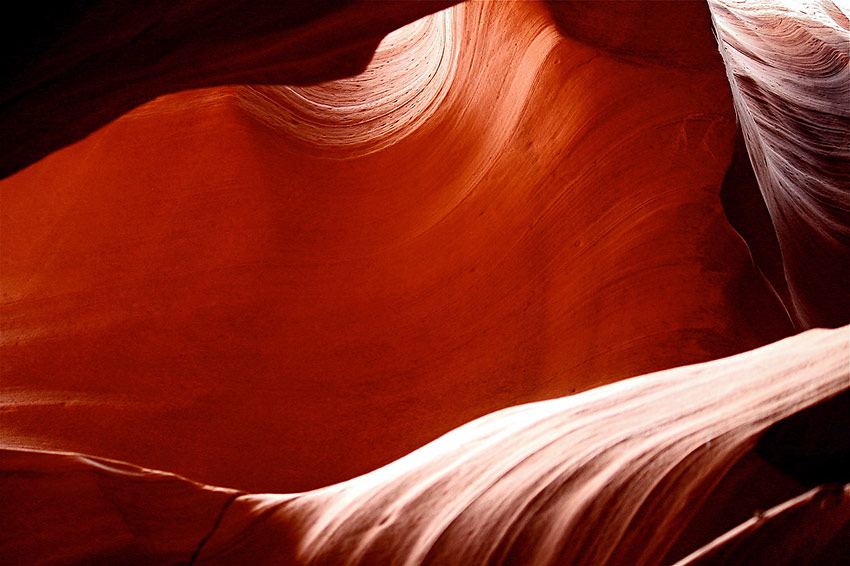
But Monument Valley is not about cowboys, it’s mostly about Indians, as it is entirely within the Navajo Indian Reservation that overlaps the Arizona/Utah border. It’s not really a valley, but that’s a handy way to collect the sandstone formations, some of which rise up several hundred meters. As one takes several hours traveling the twenty-seven kilometer dirt road that snakes through the valley and back, which affords one amazing view after another, one starts to appreciate the spiritual quality of the land that has always held such appeal for the Navajo, Hopi and other Indian tribes. This is particularly so if an Indian guide is along to explain some of the legends of creation and afterlife, and the fables based on some rock formations.
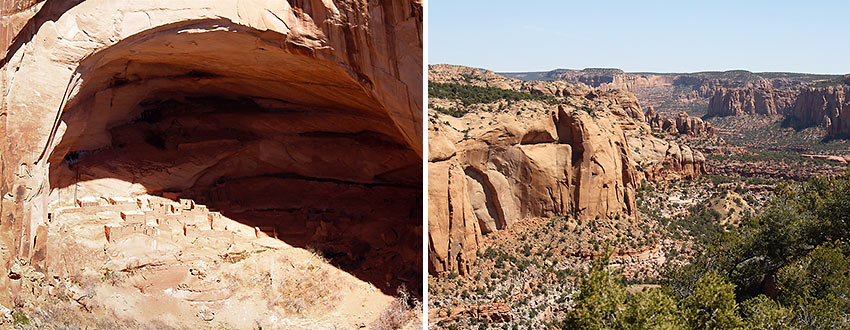
The Navajo comprise the largest of the 500 Indian tribes identified in the US Census. The Navajo Nation is about 44,000 square kilometers, about the size of West Virginia, and has a complex tribal government that is largely autonomous within the United States. The land ranges from high mountains and alpine forests to desert. Erosion from wind and water, as well as volcanic activity, have left many striking shapes including high plateaus and mesas, and canyons. As with many tribes, the land is the bedrock of tribal beliefs and of the interpretation of the world, and is often reflected in their arts. To gain an appreciation of Navajo legends, and of the historical challenges faced by the Navajo and other tribes over the past couple hundred years, stop in Tuba City and spend some time at the Navajo Interactive Museum.
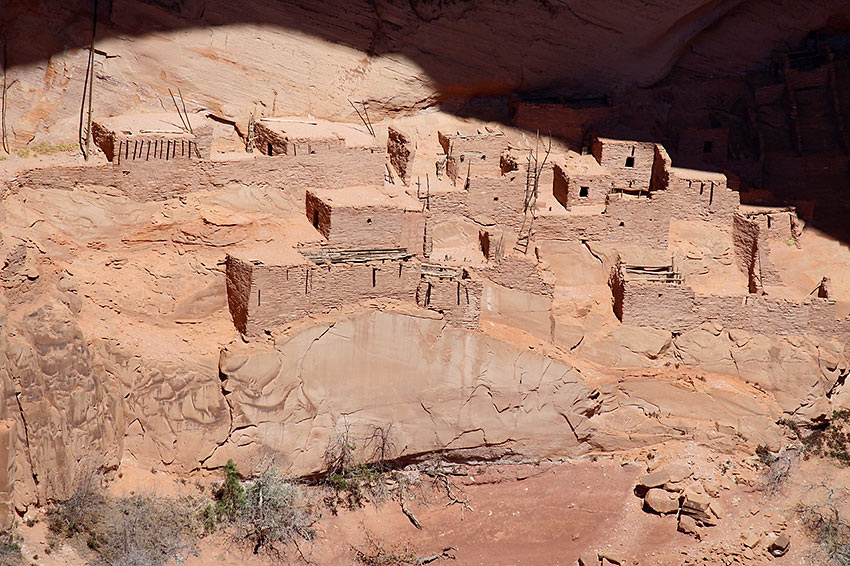
The Hopi is another tribe with long-standing roots in the region. They’ve recently opened a very intriguing hotel in Tuba City, the Moenkopi Legacy Inn, based on Indian design themes but very contemporary. Their spiritual beliefs require a very complicated series of ceremonies throughout the year. They often pay homage to hundreds of Kachina spirits, invisible life forces. Among the most joyful artistic creations of the Hopi, who are master craftsmen and artisans, are Kachina dolls carved from cottonwood and dressed like the dancers who interpret and revere them. Hopi religion is anti-war, and seeks to be at peace and in harmony with all things around them, in accordance to the instructions of Maasaw, the Creator of Caretaker of the Earth. When the Hopi perform ceremonies to this end, they do them in hope of bringing peace to the entire world.
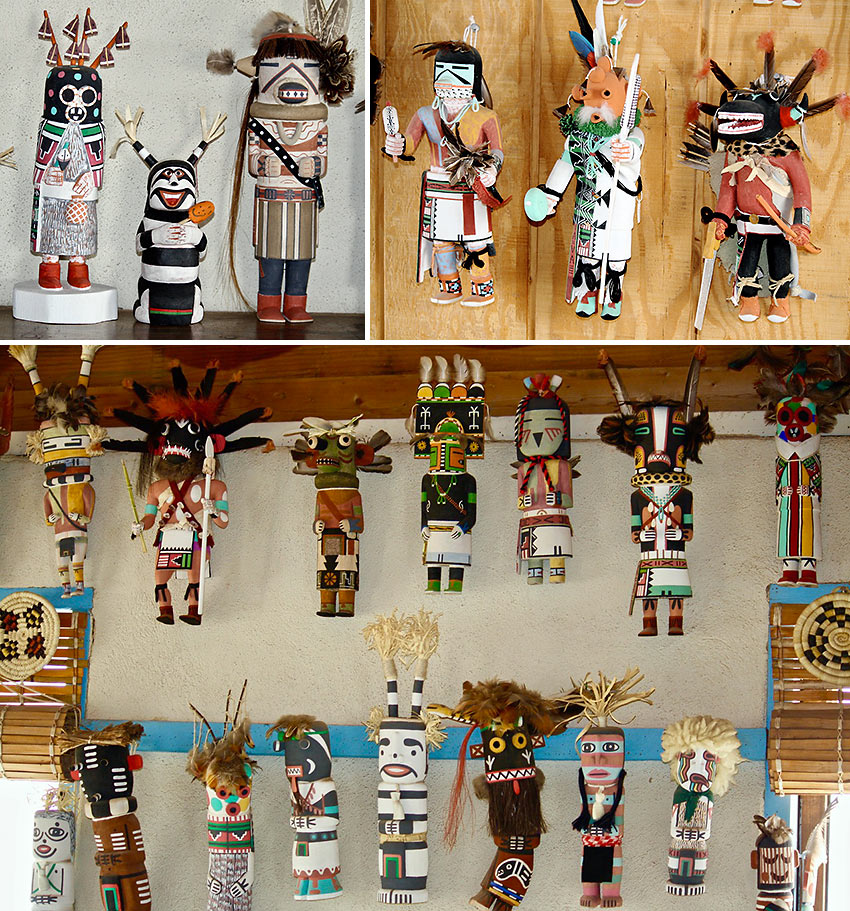
Hopi tours can be arranged that take people to the three mesas that the Hopi civilization is organized around, including First Mesa, where life remains very simple, and the village of Walpi has been continuously inhabited since 900 AD.
Another Hopi locale not to be missed is Dawa Park, surrounded by a red rock ridge over sixty meters high with thousands of petroglyphs, some unique only to that location, that date back to the Anasazai, “the ancient ones”, the ancestors of the Hopi. For half a millennium, Dawa Park was a hotbed of trading, until the arrival of the Spanish. There is evidence that some Indian traders came from as far as Central America. There is also evidence of ancient human sacrifices at the site, so the traders took commerce seriously.
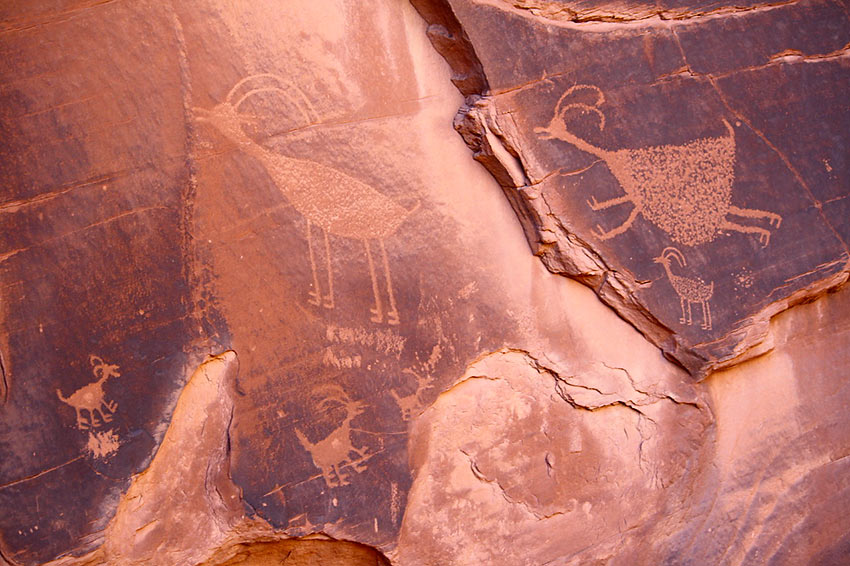
Lake Powell, which straddles the Arizona-Utah border, was formed by Glen Canyon Dam, built on the Colorado River, upstream from the Grand Canyon. The massive damn is 216 meters high, 475 meters across, 8 meters thick at the crest and 91 meters thick at the base. The damn is created from over four million cubic meters of concrete. It looks down 178 meters to the surface of the river that waters so much of the southwest and part of Mexico.
The dam was well-intentioned, generating hydroelectric power, storing and allocating water in an arid part of the country and creating tremendous water recreation offerings. Unfortunately, most assessments now view the downside to be more significant than originally thought, with negative impacts on the environment and on the aesthetic qualities of the area. For example, it was discovered that 8% of the river’s flow, worth hundreds of millions of dollars annually, disappeared between the dam and the lake, sponged into the canyon banks or evaporated. There is a movement to gradually restore the natural flow of the river, and to eventually drain down Lake Powell.
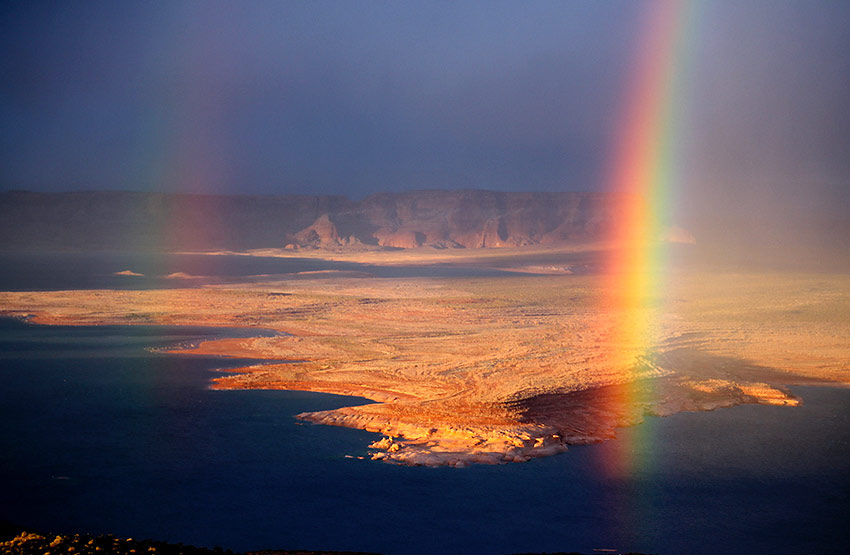
Whatever the lake’s final fate will be, and that’s unlikely to be determined any time soon, boating on Lake Powell is a stunning experience. This part of Glen Canyon is not nearly as deep as the Grand Canyon, which can reach down over 1,830 meters. The deepest parts of Lake Powell only reaches 171 meters, with rock formations rising several hundred meters above the water. But things are very relative, and even on a speed boat the lake feels like the land of giants. Indeed, it’s the second largest man-made reservoir in the country, storing up to thirty cubic kilometers of water. The lake is 300 kilometers long, but it’s the shoreline that intimidates – 3,155 kilometers, as long as the entire west coast of the continental United States. Nearly a hundred side canyons open into it. If one wants to get lost, this is the lake to do it.
The surrounding land comprises three hundred million years of geologic history that includes a great inland sea. The Colorado Plateau, through which the canyons cut, arose eleven million years ago. The reservoir is named for John Wesley Powell, a one-armed Civil War veteran who took three wooden boats and explored the Colorado River in 1869, a hair-raising adventure chronicled in the Disney film, “Ten Who Dared”.
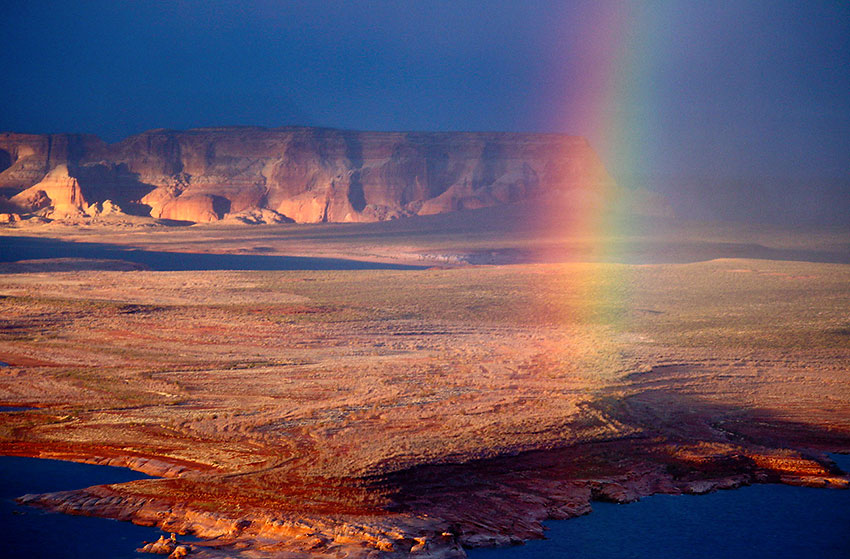
The vastness of the lake and its wild variance of cliff and rock formations can be very disorienting. I was driving a speed boat at over 86 kilometers an hour, told by my guide to continue forward and eventually swing this way or that. My anxiety levels rose because it always looked as if I was about to dash to boat to pieces on the massive rock formations looming ahead, but suddenly a large waterway, previously invisible, would open up from around some cliff or behind an island outcropping of rock, and the group I was with was spared as I redirected the boat into another very different landscape. In the Spring, with few people around, it was one private lake after another, with endless small canyons with amazing rock formations to explore. The water is clear, ranging from turquoise to deep green, and the rocks are constantly changing colors in reaction to the position of the sun. The Grand Canyon is an incomparable sight, but there’s something very cool about zooming across the water close to massive rock formations that are part of the rim of deep slashes in the earth that go far below the water, it almost feels like one is flying through the canyons.
Our guides were from Antelope Point Marina, and after a picnic in a hidden canyon waterway, we moved out into the lake until we reached our destination, a narrow canyon that, after a short hike from where the water stopped at a boat dock, allowed access to Rainbow Bridge. This was much easier than the alternative twenty-three kilometer hike over rough terrain, for which a permit is required, from a trading post at the end of an unpaved road, and in summer the heat is oppressive (most popular time of year for tourists is summer).
When the bridge comes into view, it does not disappoint. It’s described as higher than the nation’s capitol and almost as long a football field. Not counting a few large arches, depending on what aspects are measured, the Rainbow Bridge is a contender for being the largest natural bridge in the world, (there is a competitor in China, Fairy Bridge in Guangxi Province). Eighty-eight meters tall and eighty-three meters across, and at the top ten meters wide, it was carved out of sandstone by the snowmelt flowing from Navajo Mountain into the Colorado River.
It’s easy to see why the Navajo Indians consider the bridge sacred – they ask that people do not pass beneath it. For them, the bridge is a symbol of the deities that create clouds, rain and rainbows that bring forth life from the desert.
In the area of the bridge, one can see plants utilized for spiritual ceremonies by the Indians, as well as the footprint of a velociraptor, one of the deadliest predatory dinosaurs, that fortunately moved on.
Returning to the speedboat, our guides brought us to where we’d spend the rest of the day and night, on a beach all our own, in a huge section of the lake with no one else in site.
Our home was afloat, but anchored on the beach. The twenty-three meter Silver Xtreme luxury houseboat, with six private staterooms, a kitchen and common areas one would expect in a Manhattan condo. A sea food cookout was arranged on the beach, and that night from the hot tub on the top deck one could watch for shooting stars in a sky as jammed with bright stars as any place on the planet.
The biggest jaw-dropper of the American Southwest is the Grand Canyon. Here, my memory acquitted itself well, one’s first look at this canyon will always be a memory that never diminishes. In fact, I can still remember the look of frozen fear on my father’s face as he looked over to see his young boy standing precariously on a rock ledge, peering over into the vast chasm beneath, and how calmly but quickly he moved and grabbed my arm to pull me back as a strong gusts of wind pushed at us.
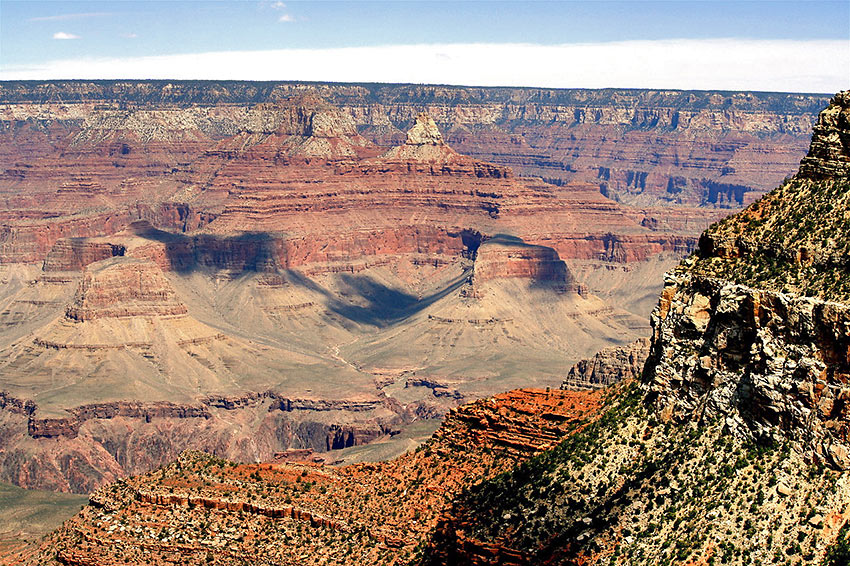
The canyon is 446 kilometers long, averaging 1,200 meters, and going as deep as 1,830 meters. It’s over 24 kilometers at it’s widest, and as one looks into it, it’s canyons within canyons, with the deepest sporting the Colorado River that helped chisel out the canyon over millions of years, in cooperation with the rising Colorado Plateau.
The actual mix of forces creating this wonder continue to be debated, and nobody knows yet if any one theory has nailed it exactly. What is known for sure is that the canyon offers one of the best geological windows on our world, and it’s easy to see why it’s one of the most studied places on the planet. The roots of the mountain range that is now at the canyon’s bottom were formed 1.7 billion years ago. Fossils of primitive algae are part of the first sedimentary layer, showing the area was coastal 1.25 billion years ago. On and on, over hundreds of millions of years, the various layers show volcanic activity and advancing and retreating oceans and seas. Both revelations and mysteries come from the progression of layers, including the puzzle of missing layers of rock. The layer we now see on top is filled with marine fossils indicating it was once beneath a sea. Seventy million years ago the Rocky Mountains – a very old mountain range – began to form, laying the groundwork for the eventual formation of the Colorado River, which began cutting through the earth – but exactly what happened next is a little fuzzy.
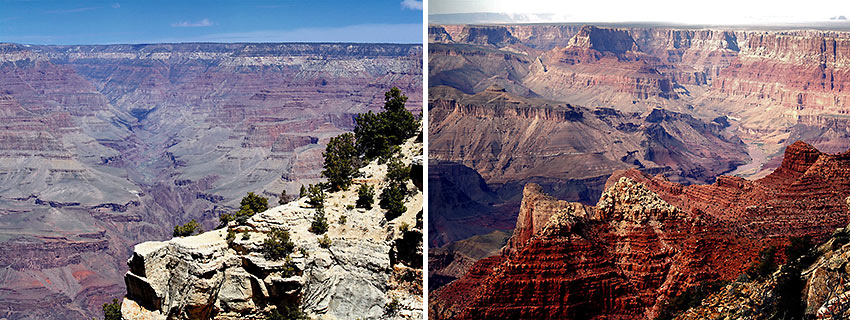
However the finishing touches were done, five million people a year come to gaze at Nature’s handiwork. The Grand Canyon includes five of the seven life zones in North America – the equivalent of traveling from Canada to Mexico – and three of four desert types. The resulting abundance of different ecosystems offer a great variance of life, including over 1,500 plant species and 355 bird species, including the extremely rare California Condor, with wing spreads of nearly three meters the largest bird in North America. Soaring on thermal updrafts, condors spend little energy gliding at over eight kilometers an hour. The 89 mammal species include mountain lion, black bear and elk. But no animal puts as many people in the emergency room as the rock squirrel, don’t offer them a peanut or otherwise mess with them.
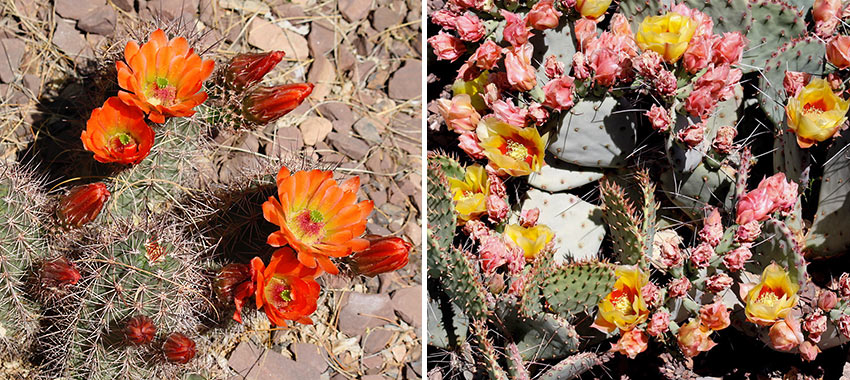
Bordering the canyon is the 1.6 million acre Kaibab National Forest, with mountains as high as 3,176 meters. Over 6,000 archeoligical and historical sites have been found in this forest. Combined with the Tonto and Coconino National Forests that lie net to the Kaibab, the result is the largest standing forestland in the US.
If one approaches the Grand Canyon from the south, one will find the flavor of the Old West alive and well in Williams, a small town that plays its historical traditions in a playful tongue in cheek manor, including street theater shoot-outs with a lot of humor as the vanquished gun-fighter keeps coming back for more until he’s finally caught one bullet too many.
Typifying the tone is Wild West Junction, a mockup of a portion of a town from the mid-1800’s, with western characters, dressed from a huge Hollywood costume collection, playing the theme to the hilt. It includes a saloon restaurant with musicians and a small Drover Hotel with rooms that each have a unique theme, such as an old style bordello or, my favorite, one filled with memorabilia of and books on the Old West portrayed in classic western movies. The owner, Bob Foster, is a former race car driver and Hollywood stunt man who became the pilot for and a good pal of the late film legend John Wayne who was most famed for his westerns. The actor had a ranch in the region, and over the years gave the Foster a good amount of memorabilia, which Foster pays homage to at the John Wayne Museum he has on the property. The best offerings are the stories Foster tells.
Williams also imparts the flavor of the roadside attractions that dotted the famous old highway Route 66, which was once seminal to the nation’s consciousness and self-image, as revealed in the old television drama “Route 66” that began in 1960. The stretch going through Williams was the last section in the country to be decommissioned, and Route 66 themes are everywhere. The bordellos and gambling houses of the town’s Wild West past are no longer here, but there’s still plenty to do with good restaurants and bars, a top golf course, activities like horseback riding and fishing, plenty of events and a new drive-through wildlife park, Bearizona. The railway operation also has a large hotel in town and a hotel inside the Grand Canyon National Park.
No one keeps the western flame alive more than the town’s Mayor, John Moore, recently re-elected with 70% of the vote. He dresses as the town sheriff and stays in character, catching a kiss from every local lady who passes him on the street. Among his enterprises are wild west reenactments such as shootouts by the Cataract Creek Gang. The most impressive is the daily train robbery of the Grand Canyon Railway as the train is on the return trip from the Grand Canyon. The train is great fun, with western singers performing in the train cars, but the pace picks up when bandits on horseback stop and board the train. The bandits are a motley crew who vary from a former Los Angeles cop who is one of the nation’s fastest quick draw pistol marksmen to a teacher working with specially challenged students.
But when they are bandits, they are bandits through and through. As I was there as a writer, they outfitted me in western garb, a Hollywood stunt pistol and a bandana mask, and sternly briefed me on the do’s and don’ts of train robberies, such as never pointing even guns without live amo anywhere but the ceiling, and not accepting the wedding rings that are occasionally offered up.
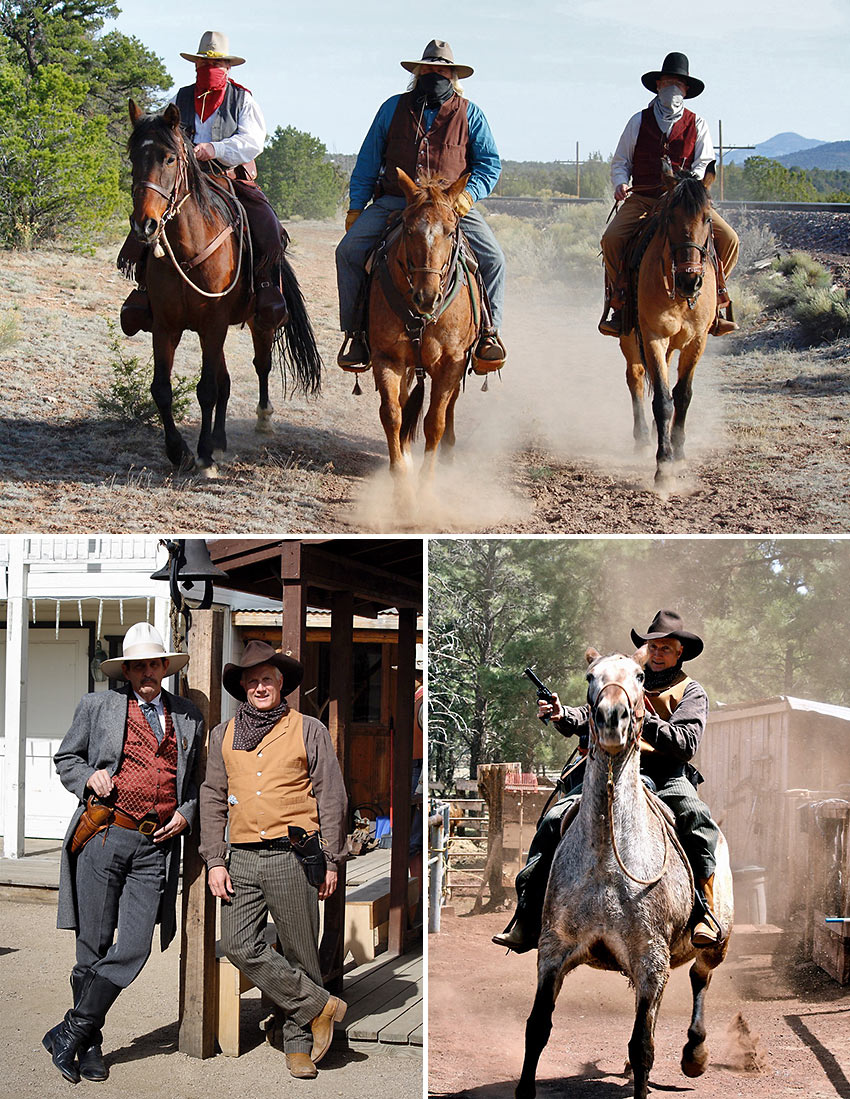
When we robbed the train, we did our best to entertain, staying in character and making glib comments, but taking care not to be offensive. Great fantasy, great fun. The train passengers were very willing victims who loved their predicament and the chance to banter with the bandits moving from train car to train car. But the forces of good overcame us, as Sheriff John Moore later came aboard, chased us throughout the train until he captured us in the last car and marched us back through in the ultimate perp walk, our hands in the air as we griped about the unfairness of it all until we got off train and it continued on unmolested. Still, when we later divvied up the loot people actually gave us, my share was twenty-nine dollars, and a new career path tempted me. So, sort of a technicality, did I actually rob a train?
If You Go
A premier tour guide operation with comfortable vans and luxury SUV’s that traverse the Southwest, is Detours
A tour guide expert on the slot canyons, Overland Canyon Tours
Antelope Point Marina at Lake Powell, which provides boats including luxury houseboats.
Amer-Indian guides for Monument Valley, Monument Valley Simpson’s Trailhandler Tours
Navajo Tourism, Monument Valley Tribal Park and Navajo Interactive Museum
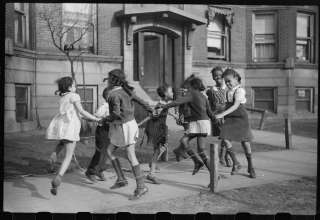
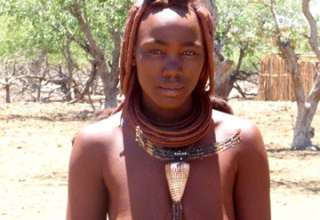
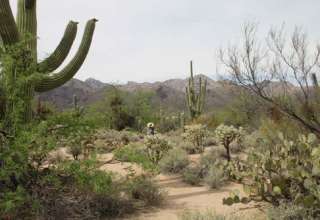
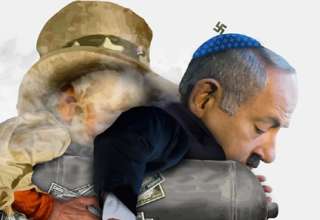
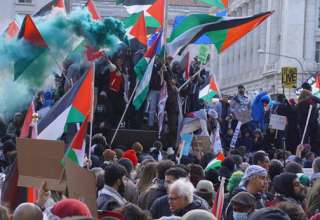
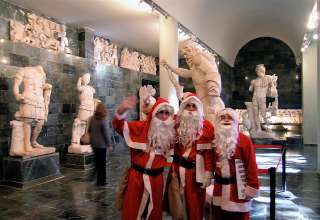
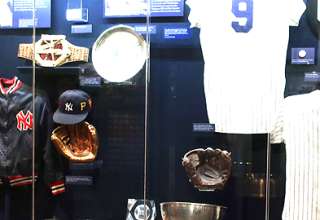
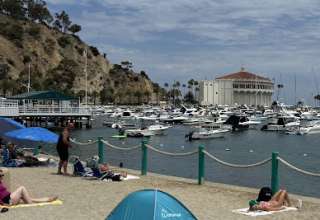

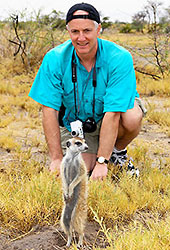 Growing up in Kansas, Skip Kaltenheuser was tuned to travel by a traveling salesman father’s pedal to the metal vacations. He extended his reach with travel writing, and efforts such as supervising elections and doing special projects. When they’re willing to slum with him, Skip’s favorite travels are still with one or both kids, now young adults, neither indicted despite living in Washington, DC their entire lives.
Growing up in Kansas, Skip Kaltenheuser was tuned to travel by a traveling salesman father’s pedal to the metal vacations. He extended his reach with travel writing, and efforts such as supervising elections and doing special projects. When they’re willing to slum with him, Skip’s favorite travels are still with one or both kids, now young adults, neither indicted despite living in Washington, DC their entire lives.